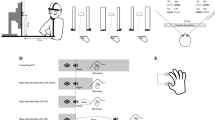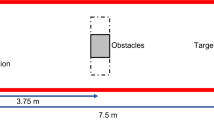Abstract
Human reaching behaviour displays sophisticated obstacle avoidance. Recently, we demonstrated that the obstacle avoidance system in normal participants is sensitive to both the position and size of obstacles (Chapman and Goodale in Exp Brain Res 191:83–97, 2008). A limitation in this previous study was that reaches were performed without visual feedback, and were not made to a specific target (i.e. the target was a long strip instead of a point). Many studies have shown that both the introduction of visual feedback and the order in which the feedback is presented (visual feedback schedule) significantly alter performance in simple visuomotor tasks (Zelaznik et al. in J Mot Behav 15:217–236, 1983). Thus, the present study was designed to compare obstacle avoidance when reaches were made to a discrete target with vision (V) and with no vision (NV) under different three visual feedback schedules (blocked, random, and alternating). Twenty-four right-handed participants performed reaches in the presence of one, two, or no obstacles placed mid-reach. In addition to replicating previous work with reaching without vision, we showed that robust avoidance behaviour occurred when reaches were made to a specific target, when reaching with only one object present, and, critically, when vision of the hand was available during the reach. Moreover, the visual feedback schedule also had a significant effect on several kinematic measures—but only on the NV trials. That is, regardless of its predictability or recent availability, vision was used in the same way for all reaches. In contrast, performance on blocked-NV trials was markedly different from performance on NV trials presented under random or alternating schedules. In addition to extending our understanding of obstacle avoidance during reaching, our results suggest that, in a complex and more natural reach-to-point task, the human visuomotor system is optimized to use visual feedback.





Similar content being viewed by others
References
Castiello U (1996) Grasping a fruit: selection for action. J Exp Psychol Hum Percept Perform 22:582–603
Chapman CS, Goodale MA (2008) Missing in action: the effect of obstacle position and size on avoidance while reaching. Exp Brain Res 191:83–97
Chua R, Elliott D (1993) Visual regulation of manual aiming. Hum Mov Sci 12:365–401
Dixon P, Glover S (2004) Action and memory. In: Ross BH (ed) The psychology of learning and motivation, vol 45, pp 143–172
Duebel H, Schneider WX (2005) Attentional selection in sequential manual movements, movements around an obstacle, and in grasping. In: Humphreys GW, Riddoch MJ (eds) Attention in action: advances from cognitive neuroscience. Psychology Press, Hove, pp 69–92
Elliott D, Allard F (1985) The utilization of visual feedback information during rapid pointing movements. Q J Exp Psychol A 37:407–425
Elliott D, Carson RG, Goodman D, Chua R (1991) Discrete vs. continuous visual control of manual aiming. Hum Mov Sci 10:393–418
Elliott D, Chua R, Pollock BJ, Lyons J (1995) Optimizing the use of vision in manual aiming: the role of practice. Q J Exp Psychol A 48:72–83
Elliott D, Binsted G, Heath M (1999) The control of goal-directed limb movements: correcting errors in trajectory. Hum Mov Sci 18:121
Elliott D, Helsen WF, Chua R (2001) A century later: Woodworth’s (1899) two-component model of goal-directed aiming. Psychol Bull 127:342–357
Fukui T, Inui T (2006) The effect of viewing the moving limb and target object during the early phase of movement on the online control of grasping. Hum Mov Sci 25:349–371
Heath M (2005) Role of limb and target vision in the online control of memory-guided reaches. Mot Control 9:281–311
Heath M, Westwood DA, Binsted G (2004) The control of memory-guided reaching movements in peripersonal space. Mot Control 8:76–106
Heath M, Rival C, Neely K (2006) Visual feedback schedules influence visuomotor resistance to the Muller-Lyer figures. Exp Brain Res 168:348–356
Jackson SR, Jackson GM, Rosicky J (1995) Are non-relevant objects represented in working memory? The effect of non-target objects on reach and grasp kinematics. Exp Brain Res 102:519–530
Jakobson LS, Goodale MA (1991) Factors affecting higher-order movement planning: a kinematic analysis of human prehension. Exp Brain Res 86:199–208
Jax SA, Rosenbaum DA (2007) Hand path priming in manual obstacle avoidance: evidence that the dorsal stream does not only control visually guided actions in real time. J Exp Psychol Hum Percept Perform 33:425–441
Jax SA, Rosenbaum DA (2008) Hand path priming in manual obstacle avoidance: rapid decay of dorsal stream information. Neuropsychologia 47:1573–1577
Khan MA, Elliott D, Coull J, Chua R, Lyons J (2002) Optimal control strategies under different feedback schedules: kinematic evidence. J Mot Behav 34:45–57
Khan MA, Franks IM, Elliott D, Lawrence GP, Chua R, Bernier PM, Hansen S, Weeks DJ (2006) Inferring online and offline processing of visual feedback in target-directed movements from kinematic data. Neurosci Biobehav Rev 30:1106–1121
McIntosh RD, McClements KI, Dijkerman HC, Birchall D, Milner AD (2004a) Preserved obstacle avoidance during reaching in patients with left visual neglect. Neuropsychologia 42:1107–1117
McIntosh RD, McClements KI, Schindler I, Cassidy TP, Birchall D, Milner AD (2004b) Avoidance of obstacles in the absence of visual awareness. Proc Biol Sci 271:15–20
Messier J, Kalaska JF (1999) Comparison of variability of initial kinematics and endpoints of reaching movements. Exp Brain Res 125:139–152
Milner AD, McIntosh RD (2004) Reaching between obstacles in spatial neglect and visual extinction. Prog Brain Res 144:213–226
Mon-Williams M, Tresilian JR, Coppard VL, Carson RG (2001) The effect of obstacle position on reach-to-grasp movements. Exp Brain Res 137:497–501
Neely KA, Tessmer A, Binsted G, Heath M (2008) Goal-directed reaching: movement strategies influence the weighting of allocentric and egocentric visual cues. Exp Brain Res 186:375–384
Rice NJ, McIntosh RD, Schindler I, Mon-Williams M, Demonet JF, Milner AD (2006) Intact automatic avoidance of obstacles in patients with visual form agnosia. Exp Brain Res 174:176–188
Rice NJ, Edwards MG, Schindler I, Punt TD, McIntosh RD, Humphreys GW, Lestou V, Milner AD (2008) Delay abolishes the obstacle avoidance deficit in unilateral optic ataxia. Neuropsychologia 46:1549–1557
Rosenbaum DA, Cohen RG, Jax SA, Weiss DJ, van der Wel R (2007) The problem of serial order in behavior: Lashley’s legacy. Hum Mov Sci 26:525–554
Rosenbaum DA, Cohen RG, Dawson AM, Jax SA, Meulenbroek RG, van der Wel R, Vaughan J (2009) The posture-based motion planning framework: new findings related to object manipulation, moving around obstacles, moving in three spatial dimensions, and haptic tracking. Adv Exp Med Biol 629:485–497
Schindler I, Rice NJ, McIntosh RD, Rossetti Y, Vighetto A, Milner AD (2004) Automatic avoidance of obstacles is a dorsal stream function: evidence from optic ataxia. Nat Neurosci 7:779–784
Tipper SP, Howard LA, Jackson SR (1997) Selective reaching to grasp: evidence for distractor interference effects. Vis Cogn 4:1–38
Tresilian JR (1998) Attention in action or obstruction of movement? A kinematic analysis of avoidance behavior in prehension. Exp Brain Res 120:352–368
van der Wel RP, Fleckenstein RM, Jax SA, Rosenbaum DA (2007) Hand path priming in manual obstacle avoidance: evidence for abstract spatiotemporal forms in human motor control. J Exp Psychol Hum Percept Perform 33:1117–1126
Whitwell RL, Goodale MA (2009) Updating the programming of a precision grip is a function of recent history of available feedback. Exp Brain Res 194:619–629
Whitwell RL, Lambert LM, Goodale MA (2008) Grasping future events: explicit knowledge of the availability of visual feedback fails to reliably influence prehension. Exp Brain Res 188:603–611
Zelaznik HZ, Hawkins B, Kisselburgh L (1983) Rapid visual feedback processing in single-aiming movements. J Mot Behav 15:217–236
Author information
Authors and Affiliations
Corresponding author
Rights and permissions
About this article
Cite this article
Chapman, C.S., Goodale, M.A. Seeing all the obstacles in your way: the effect of visual feedback and visual feedback schedule on obstacle avoidance while reaching. Exp Brain Res 202, 363–375 (2010). https://doi.org/10.1007/s00221-009-2140-7
Received:
Accepted:
Published:
Issue Date:
DOI: https://doi.org/10.1007/s00221-009-2140-7




